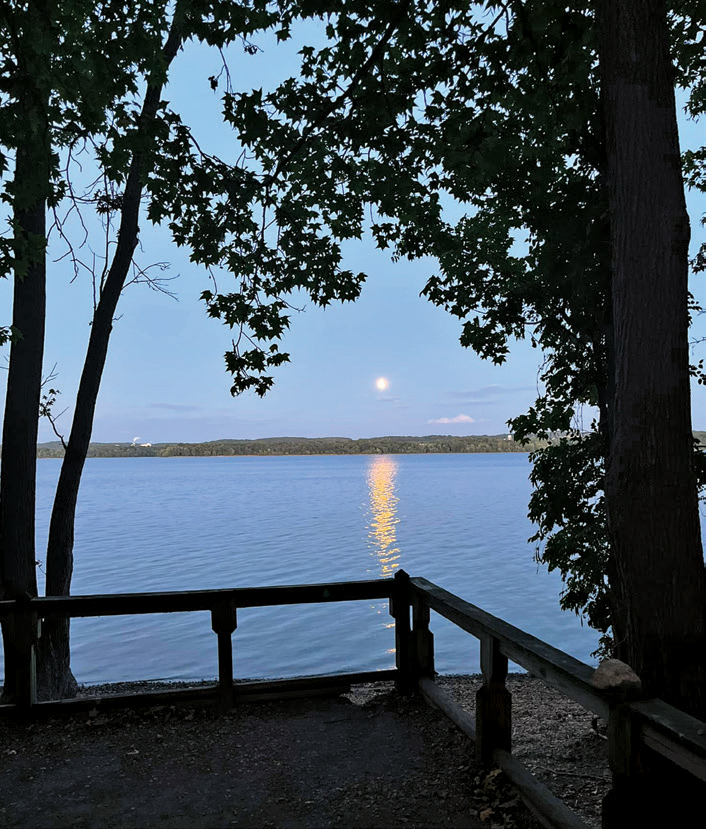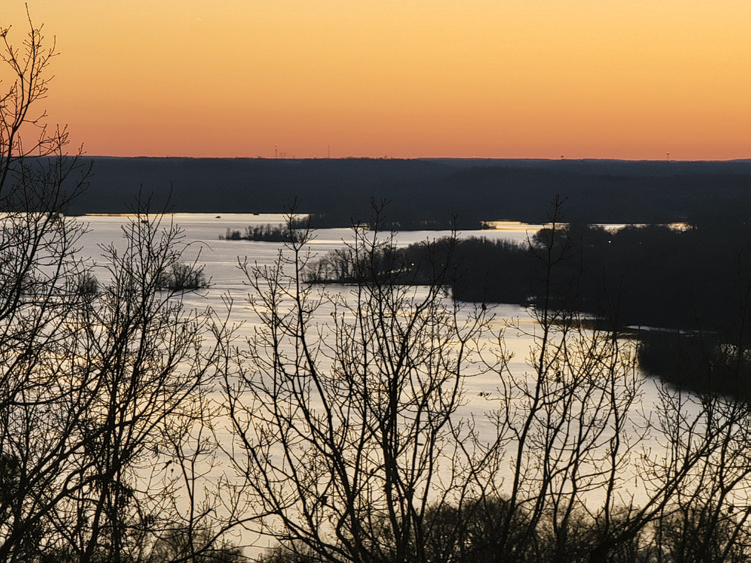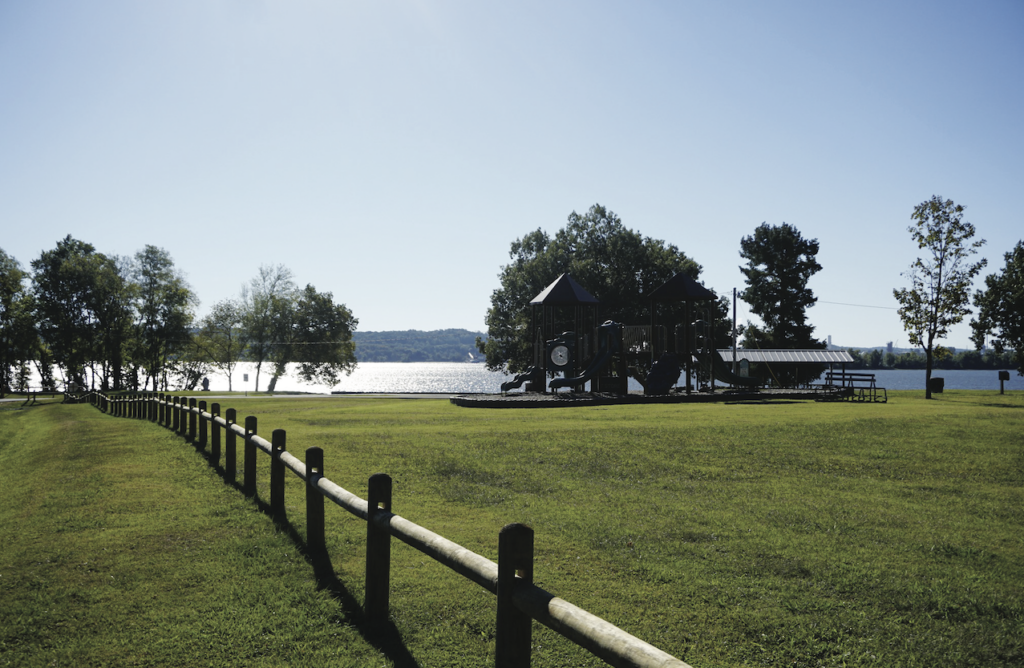Nathan Bedford Forrest State Park offers much to many
Photographs by Josh Justice
On any given day, the managers of Tennessee’s state parks have interesting interactions with visitors. Some could involve sharing accumulated knowledge about historical sites within their parks. Others include answering questions for campers or hikers. Some of the best, however, revolve around helping shape young visitors’ experiences with parks. Some of those encounters leave lasting impressions not only with the children but also the managers, as one such interaction did for Josh Justice, park manager at Nathan Bedford Forrest State Park in Eva (Benton County).
“I have many stories that I could tell, and most of them would be about teaching children about nature,” Justice says. “One in particular sort of stands out. I was making my normal rounds one afternoon and stopped by the Folklife Center to see if the clerk needed anything. She was busy with guests, so I helped out by talking to some of them. One family asked about our captive snakes. I started talking to them and offered to get one out. Most of the family answered with a firm ‘NO,’ but the youngest daughter, probably around 3 (years old), said she wanted to see one of them. I got out our corn snake and started to show him and talked to her. Before long, the entire family was talking about him and petting him. If we all still had the curiosity of a 3-year-old girl, the world may be a better place. It only took her asking questions to change the outlook of the entire family.”

A bit of backstory
Long before that curious little girl wanted to see a snake, long before the Tennessee River Folklife Interpretive Center was even built or the park became a park, this area was home to indigenous peoples. But, like many other parks that blend history and recreation, the history part is what most visitors overlook while visiting, Justice says.
“We are trying to get interpretive signage showcasing this history,” he says. “We have the Eva Archaic Site that was used for generations, the Trail of Tears routes that came through the park, Civil War events in the area, CCC (Civilian Conservation Corps) and WPA (Works Progress Administration) projects on the park, TVA (Tennessee Valley Authority) and just the life in the area before it became a park that we want to promote. Some of this is already being done, but we are trying to build on that and tell as many stories as possible.”
The Folklife Center is a great place to learn more about the area’s history and the ways people living along the river have made use of it in various ways to survive for generations — musseling, fishing, making crafts and more. Here you can also request to see any of the films available on the river life, park history or the area’s Civil War history.
Natural and cultural appeal
Located on the western bank of Kentucky Lake, Nathan Bedford Forrest State Park is different from other parks in the area because it has elevation change.
“Our trail system is not flat like most other West Tennessee parks,” Justice says. “Our Tennessee River Folklife Center is located on Pilot Knob, one of the highest elevations in West Tennessee. We have approximately 20 miles of trails that take advantage of this elevation change.”
These range in length and difficulty from the 0.3-mile easy Polk Creek Wildflower Trail to the Nathan Bedford Forrest 20-Mile Trail that is rated moderate to difficult. All trails are natural surface.
Because of the park’s location next to the river, not only will you be likely to spot or hear forest-dwelling songbirds or raptors while hiking the trails, but you also might see waterfowl such as herons, egrets and gulls.
While the river has been a way to make a living for many in the most subsistence sense, it also provides leisure and ways of making money in catering to the people seeking a day of recreation on the water. Anglers aplenty try their luck at catching bass, catfish, bluegill, redear sunfish and crappie.
Other ways to enjoy the expanse of the Tennessee River/Kentucky Lake are boating, paddleboarding, kayaking or even swimming at the park’s Eva Beach site. Granted, it’s going to be too chilly to do that for a while, but check it out when warmer temperatures return.
More to offer
The park is one of only a few in the Tennessee State Parks system that offers a disc golf course. Different aspects of this course appeal to different levels of players from the beginner to those who are more experienced in the sport.
Several special events are also hosted in the park each year.
“Along with the normal holiday weekend festivities, we have three larger events,” Justice says. “We have the Eva Beach Music and Arts Festival on the third Saturday of September every year. We have the Pilot Knob 10K race in October. And we have our Fall Festival the weekend before Halloween each year.”
Ranger-led programming throughout the year allows visitors to learn more about reptiles, owls, history, archery skills, astronomy and various other interesting topics. Enjoy canoe floats, roasting marshmallows and telling stories around a campfire, hikes such as the annual Spring Hike in March, a fishing rodeo in June and Christmas festivities.
If you’d like to stay more than a day to enjoy all the park has to offer, you have in-park options for accommodations. Deluxe two-bedroom cabins overlooking the lake; a refurbished 1930s rustic cabin on a secluded ridge, also with a lake view; and numerous campground sites are available for rental.

Telling full stories
Students of history will recognize that the park’s namesake is a controversial figure. Though named after him, the park land and the history that resides here go beyond and before Forrest, and the full scope of that history is what park staff endeavor to share.
“At Nathan Bedford Forrest State Park and across Tennessee State Parks, we follow a ‘Telling Full Stories’ process,” Justice says. “A full story addresses all the people present on a site or in a culture, including those who have been underrepresented, misrepresented or unrepresented in previous cultural and historical dialogues. We understand that each person who visits the park will have a different idea or perception on Nathan Bedford Forrest. We are not here to change their minds or steer them in any way. We tell the facts of what happened in the area of the park in the fullest way we can. We want all people to learn the history of this park, and that is just one part of it.”
Fun for everyone
“We are a family-oriented park,” Justice says. “Most weekends here are like a family reunion, only most of them aren’t related. We have kids playing in the creeks, kids on bicycles, visitors gathering at campsites for dinner. It almost reminds me of the way neighborhoods used to be: people enjoying being outside and enjoying the company of their neighbors. The staff helps out by planning wagon rides, creek walks and crafts for everyone to enjoy. And we do a kayak float almost every weekend.
“And I want to mention our steps to be more accessible to all visitors. We currently have an ADA (Americans with Disabilities Act) fishing pier at Eva Beach, an ADA all-terrain wheelchair that guests can use and an adult changing station at the Folklife Center, and we are updating our campgrounds, which will include many more ADA campsites.”

Nathan Bedford Forrest State Park
For more information, visit tnstateparks.com/parks/nathan-bedford-forrest or call the office at 731-593-6445.




